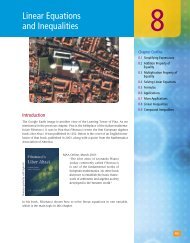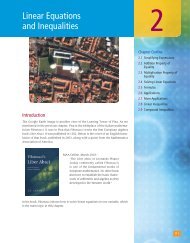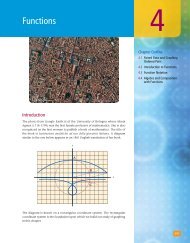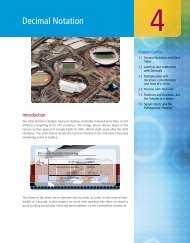Chapter 9 - XYZ Custom Plus
Chapter 9 - XYZ Custom Plus
Chapter 9 - XYZ Custom Plus
Create successful ePaper yourself
Turn your PDF publications into a flip-book with our unique Google optimized e-Paper software.
Introduction . . .<br />
Linear Equations in One Variable<br />
The Rhind Papyrus is an ancient Egyptian document,<br />
created around 1650 bc, that contains<br />
some mathematical riddles. One problem on the<br />
Rhind Papyrus asked the reader to find a quantity<br />
such that when it is added to one-fourth of<br />
itself the sum is 15. The equation that describes<br />
this situation is<br />
x 1 }}<br />
1 4 }x<br />
x 5 15<br />
As you can see, this equation contains a fraction. One of the topics we will discuss<br />
in this section is how to solve equations that contain fractions.<br />
In this chapter we have been solving what are called linear equations in one<br />
variable. They are equations that contain only one variable, and that variable is<br />
always raised to the first power and never appears in a denominator. Here are<br />
some examples of linear equations in one variable:<br />
3x<br />
1 2 5 17, 7a 1 4 5 3a 2 2, 2(3y<br />
2 5) 5 6<br />
Because of the work we have done in the first three sections of this chapter, we<br />
are now able to solve any linear equation in one variable. The steps outlined below<br />
can be used as a guide to solving these equations.<br />
Bridgeman Art Library/Getty Images<br />
9.4<br />
Objectives<br />
A Solve linear equations with one<br />
variable.<br />
b Solve linear equations involving<br />
fractions and decimals.<br />
C Solve application problems using<br />
linear equations in one variable.<br />
Examples now playing at<br />
MathTV.com/books<br />
A<br />
Solving Linear Equations with One variable<br />
Strategy Solving a Linear Equation with One Variable<br />
Step 1: Simplify each side of the equation as much as possible. This step is<br />
done using the commutative, associative, and distributive properties.<br />
Step 2: Use the addition property of equality to get all variable terms on one<br />
side of the equation and all constant terms on the other, and then<br />
combine like terms. A variable term is any term that contains the variable.<br />
A constant term is any term that contains only a number.<br />
Note<br />
Once you have some<br />
practice at solving<br />
equations, these steps<br />
will seem almost automatic. Until<br />
that time, it is a good idea to pay<br />
close attention to these steps.<br />
Step 3: Use the multiplication property of equality to get the variable by itself<br />
on one side of the equation.<br />
Step 4: Check your solution in the original equation if you think it is necessary.<br />
ExAmplE 1 Solve: 3(x<br />
1 2) 5 29<br />
SOlutiOn<br />
We begin by applying the distributive property to the left side:<br />
Step 1<br />
Step 2<br />
Step 3<br />
5<br />
5<br />
5<br />
3(x<br />
1 2) 5 29<br />
3x<br />
1 6 5 29 Distributive property<br />
3x<br />
1 6 1 (−6) 5 29 1 (−6) Add 26 to both sides<br />
3x<br />
5 215 Addition<br />
} 3x<br />
x 215 } 5 }} Divide both sides by 3<br />
3 3<br />
x 5 25<br />
Division<br />
prACtiCE prOblEmS<br />
1. Solve: 4(x<br />
1 3) 5 28<br />
Answer<br />
1. 25<br />
9.4 Linear Equations in One Variable<br />
539

















